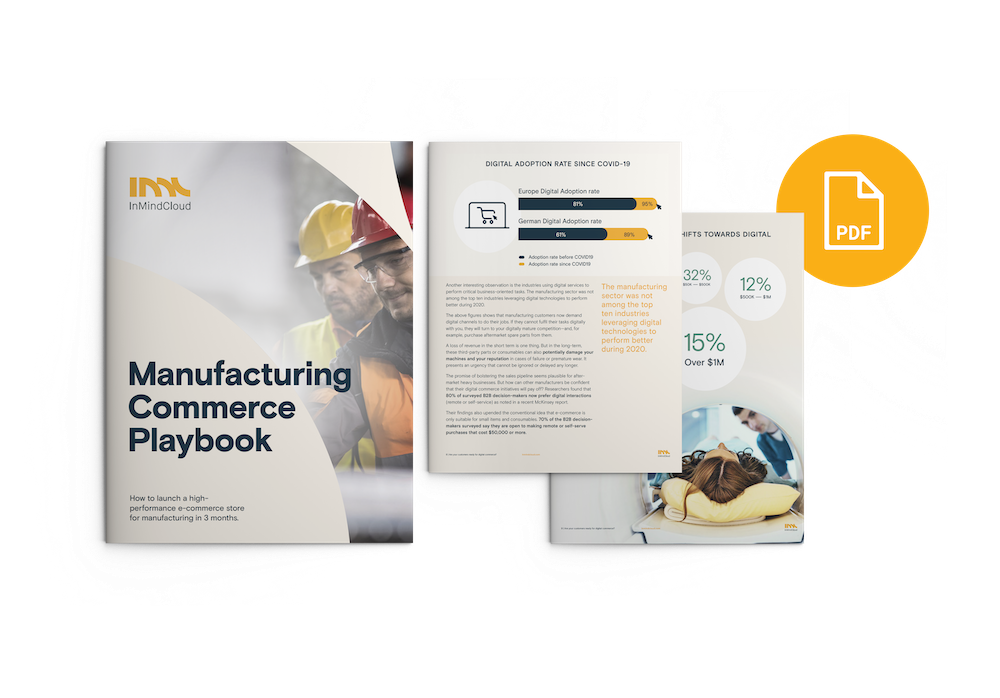E-commerce is no longer a B2B trend. It is a necessity that found its way into every sector, even manufacturing. Leading manufacturers have learned that having an integrated commerce portal helps them secure market share, customer loyalty, and seize new growth opportunities.
Today, your customers are increasingly sourcing and buying online—making your commerce portal a critical tool that helps your manufacturing business increase sales. With e-commerce, new innovations can be made available instantly to your customers.
Integrated online portals can easily pull and display the most accurate prices, costs, specifications, and all kinds of sales-related data from your ERP. Populating your online store becomes a simple process. To take advantage of this speed, your product description should be as comprehensive as possible. It needs to sell the product as quickly as your best salesperson.
A Digital Sales Platform can help your business open new sales channels and ensure your customers keep coming back. Download our Manufacturing Commerce Playbook to discover how digital can transform manufacturing sales and keep your revenue flowing.
Why are product descriptions important in B2B online sales?
For manufacturers, B2B product descriptions should be more than just numbers and specs. That’s because you could have multiple models for products with similar functions. Product descriptions can help your customers cut through specs and find what they need quickly.
A product description can help provide critical information about the product in a way that specifications can't. You can help your customers understand the effort that went into the design, the customer pain points behind new innovations, and, more importantly, your confidence in the product—and why it’s perfect for your customers’ use cases.
If your spec sheets appeal to the logical part of your customer’s mind, then the product description should appeal to the emotional part of their minds—a two-pronged approach to convince your customers that your product is the best fit.
In B2C, leading manufacturers use attention-grabbing product descriptions complete with snappy headlines that take 60 seconds to digest. It lets readers understand what they are buying and gives them the confidence that they are buying the RIGHT product.
In B2B, manufacturers often build a product description purely on technical facts and spend less time on creating a well-rounded piece. This should be reconsidered because your buyers are consumers too.
Example:
Pump model A has a flow maximum of 55 I/s and costs $500. Pump model D has a flow maximum of 130 I/s and costs $1000. Highly experienced engineers can tell you exactly which pump is needed for the job with just these two numbers.
But the reality is, your customers don’t always get the most qualified person to buy solutions. There could even be multiple stakeholders involved—most of whom do not possess the relevant technical background to identify and buy the product or solution needed.
These people would be relying on additional information like how (or why) the more expensive model is built to be more robust and much more suitable for the company’s particular needs. It takes effort to relay this information to your customers, but it can prove valuable in the long run—especially if your competitors don’t furnish buyers with the same information.
Buyer personas are key to your manufacturing product description
Understanding the buyer is the most crucial first step when you’re creating product descriptions. When you know who you are talking to, you can include information that resonates with them. This information should ideally talk about their use cases, business goals, and how the product addresses their pain points or concerns.
Example:
Let’s take ophthalmic polishing machines, for example. Product descriptions written for the high-level decision-makers would highlight how smart the software is (easy to use), how the tools are built to last (lower repair costs), the flexibility to polish all kinds of geometries and materials (lower capital expenditure). Your primary message—about why it’s better for the customer—can’t be conveyed simply with spec sheets.
Put your best USP forward in your B2B online store
Once you’ve got the target persona’s attention, you only have seconds to make an impression. Placing your USP front and center would be the most direct way to get your message across. Your USP, or unique selling point, is the added value that makes your product stand out in the crowded market.
Example:
If harsh environments damaging farming equipment fast was the top pain point in the agricultural industry, you want to let your customers know that your solutions come with an industry-leading 10-year bumper-to-bumper warranty instead of the industry standard of 5-years.
Traditionally, manufacturers typically leave it to their sales teams to talk about (or sell) the USP of their products. But when you have an online commerce portal, your USPs can be laid out for your customers 24/7—a constant reminder for customers that your products are better.
Creativity is not wasted on the B2B buyer
In B2B marketing, creativity can be expressed through a unique story instead of writing flair. The ones who often find creative stories to sell otherwise mundane products are the salespeople. The best salespeople always weave a story that sells the experience to the customer instead of relying solely on discounts (which customers still love).
They would tell their customers that the industry-leading 10-year warranty means that the business is confident in the quality of its products and that customers would have a worry-free ten years if they bought it. The idea is to find the right story and tell customers how they will benefit from buying your products versus buying from competitors.
With support from digital sales, the salesperson can go on to confidently seal the deal with an attractive - yet not margin damaging - discount that’s automatically calculated by the system.
Educate with value. Not confuse with jargon.
Speaking the same language as your customers can help them relate to your messages better. The same is true for B2B product descriptions. However, there is a fine line between engaging customers and confusing them with corporate jargon.
Before drafting the product description, have a conversation with your top sales reps. Chances are, they use simple straight forward language when selling. Just like your product page, they only have minutes to tell their story and sell the product.
That means product descriptions should be a specific, highly concise version of the story they tell customers. What you want, is to quickly educate customers on why your product is better. Not confuse them with too much industry jargon.
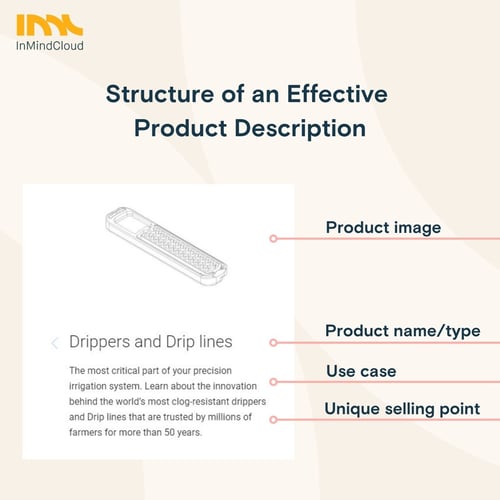
An effective product description contains the necessary information needed to convince potential buyers.
Writing product descriptions requires some thought--but not too much. In the illustration above, we have a basic structure of an effective product description.
An effective product description contains these elements
-
A precise image of the product.
- It can be a photograph or an engineering drawing. As long as it is instantly recognizable for your customers.
-
The product model, name, or type.
- This helps customers quickly navigate towards it--especially if your digital catalog comprises thousands of items.
-
What the product can be used for.
- Sometimes, buyers can't tell what they need with just pictures. Having a brief description helps the buyer clear up any confusion.
-
The product's unique selling point.
- This element lets manufacturers explain exactly why the product is better than the products from their competitors.
Make product descriptions “internet-ready” with SEO
Now that you have some idea of what a sound product description is, here’s how you can get it ready for the internet. Like on your favorite B2C online store, the best product descriptions are written with search engine optimization (SEO) in mind. This makes products much easier for your customers to find if they simply search for them via a search engine.
For example, when customers search for “drip irrigation system,” you want the search engine to serve up your drip irrigation solution page. Leading search engines typically do not reveal how their algorithm works. However, there are many best practices that can help you create an SEO-friendly product description.
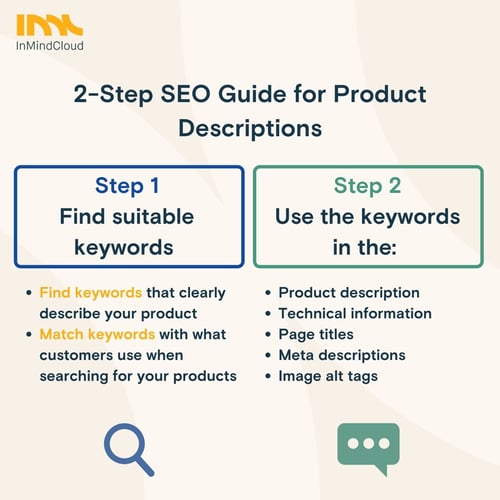
Follow these two simple steps to write a product description that sells your products.
SEO is a complex topic that can confound even seasoned digital marketers. However, for product descriptions, you just need to these two steps. Find the right keywords, and use them throughout the product page.
Ideally, these keywords can be tested to find the right combination. But, as a manufacturer, this may not be feasible due to a large catalog. If you have hundreds of product pages, simply following these two steps should be sufficient. However, for key products or categories, manufacturers can add a third step, which is to measure copy length and keywords for the best combination.
The 2 (+1) step guide for product descriptions
Step 1: Find suitable keywords
- Keywords are words that accurately describe your product. Layman terms work best, but don't rule out industry terms either. These keywords need to match what your customers are searching for. If you use only terms that your manufacturing business uses, you may miss out on potential customers finding your product page.
Step 2: Be generous with your keywords
- Once you find the right keywords, be sure to use them throughout the product page. Ensure that the appropriate keywords can be found in the description, technical information, titles, meta descriptions, and image alt tags. However, take care not to overuse them or use them out of context. Keywords that do not match your product can even have a negative impact on the product page.
Step 3 (optional): Test and measure combination
- In digital marketing, placement, language, image dimensions, and so on, play an important role in convincing your customers to buy. For better results, you can conduct tests to find the USP that works or to discover the keywords that bring customers in.
How to write B2B product descriptions fast
Products manufactured for B2B have particular use cases. It makes writing product descriptions a simple, straightforward process. Here’s a quick recap of how you can write compelling product description copy fast.
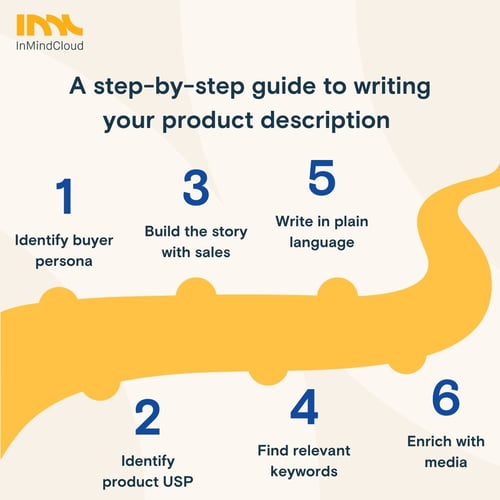
There are 6 steps you can take to craft the ideal product description for your products.
Earlier in the article, we covered some of the key steps that can help you write an effective product description. Once you have understood the concept behind these steps, writing a product description becomes much easier.
Here are the 6 steps you can take:
-
Identify the buyer persona - It's important to write for the person who is the actual buyer of the product. Sometimes, it may not be the person with the highest level of technical knowledge.
-
Identify the product USP - There are only a few things most of your buyers care about. Use these facts or figures to convince customers that they are looking at the product they need.
-
Build the story with sales - Internal salespeople may already be using a creative story to sell your products. Have a conversation with them to align the story, or improve it further.
-
Find relevant keywords - Use only the keywords that best describe your product, and are the ones that your customers are using in their online searches for problem-solving solutions.
-
Write in plain language - Avoid using too many corporate or industry-insider terms that can confuse the buyer. Use language that your customers can relate to, but is simple enough to read fast.
-
Enrich with media - Use high-quality photos or videos to help the buyer understand what the product is about. You can even use illustrated versions of the product.
Enrich with 2D, 3D, or interactive images and videos
Now that you have the product description, it’s time to enrich it. Creating media-rich product pages can help customers get a better overview of the product they are about to buy. Videos are great for helping customers visualize what to expect with the product. Manufacturers can also consider using 3D or interactive images. Exploded views can be used to help customers identify and buy spare parts fast.
Example 1: 3D product visualization
Example of using 3D visualization to give customers an overview of the product
3D and interactive visualization are powerful tools that can help customers find and buy what they need fast
Example 2: Visual product search and selection
2D exploded-views can help customers find the right spare parts for your highly complex products
Example 3: Media-rich product pages
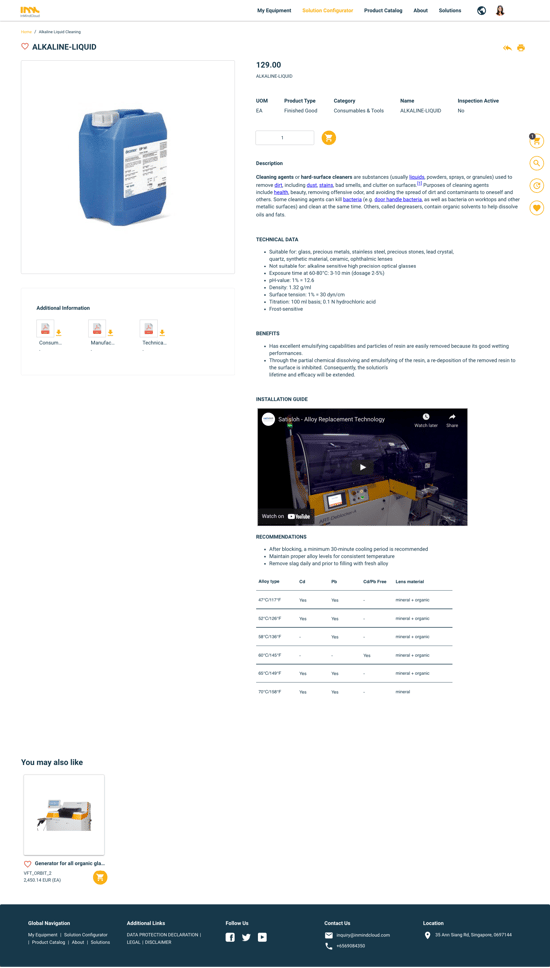
A Digital Sales Platform equips manufacturers with the tools to enrich their sales data with marketing material easily
We just gave you a glance into how you can make it easier for your customers to buy your complex products and solutions. Book a no-obligation demo with one of our manufacturing experts to check out how this could look like for you.
Summary
An effective product page comprises a description supported by technical specifications, images, and videos. This combination works together to answers all the questions your customers have.
This not only leads to a better buying experience; it also helps your sales team eliminate the time-consuming task of answering minor inquiries from customers—allowing them to be more productive at selling.
Download our Manufacturing Commerce Playbook and find out how you can get a high-performance manufacturing e-commerce store up and running in 3-months, and keep your costs low with a cloud-based Digital Sales Platform.

 Deutsch
Deutsch


